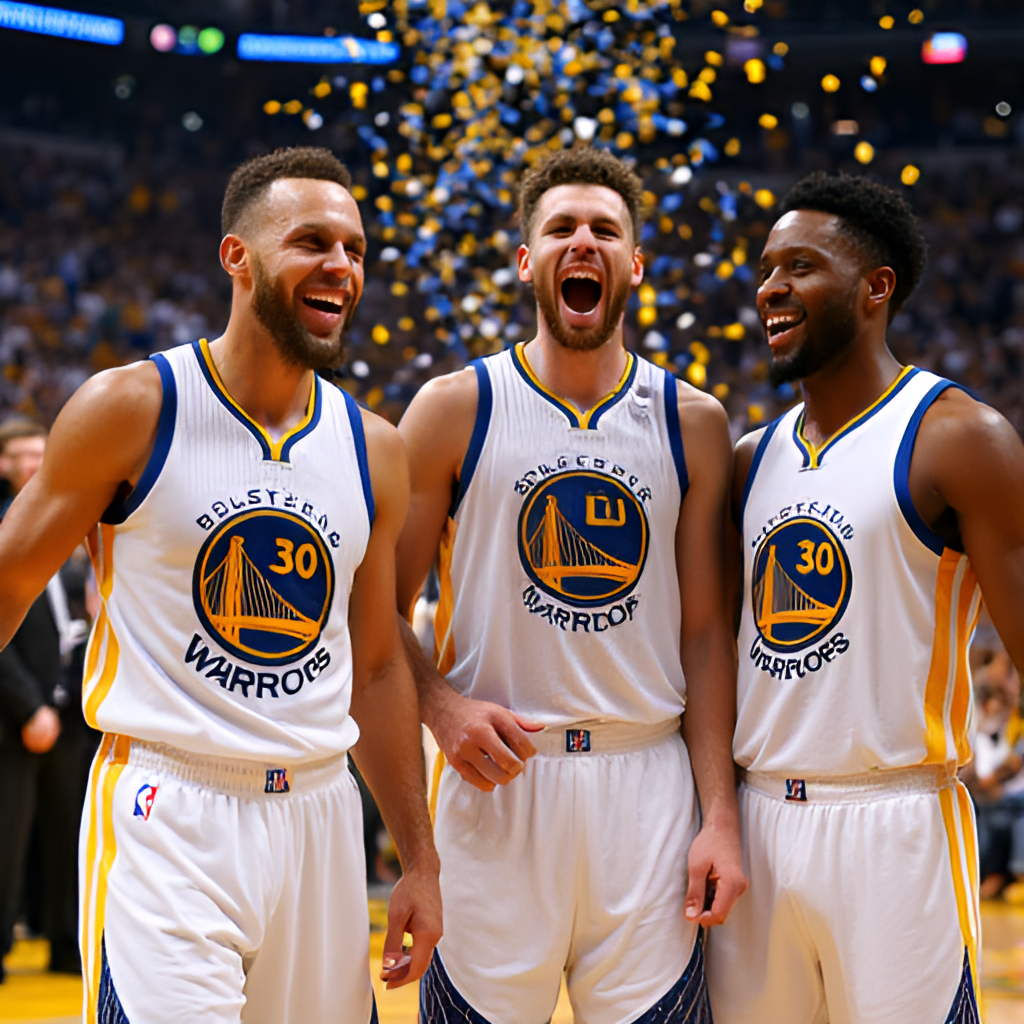Golden State Warriors: The Dynasty and Beyond
- The Golden State Warriors: More Than Just a Basketball Team
- From Philadelphia to Golden State: Early Years and First Championships
- The “Run TMC” Era: A Glimpse of Excitement
- The Dynasty Begins: Curry, Thompson, and Green
- Adding a Superstar: The Durant Era
- A New Home in San Francisco: The Chase Center
- Beyond the Dynasty: Navigating Challenges and the Future
- The Enduring Legacy of the Golden State Warriors
The Golden State Warriors are more than just a basketball team; they’re a cultural phenomenon, a symbol of Bay Area pride, and architects of a modern NBA dynasty that redefined how the game is played. As someone who’s followed their journey for years, witnessing the highs and lows, I can honestly say there’s a unique energy surrounding the Golden State Warriors that captivates fans worldwide. This isn’t just about wins and losses; it’s about a style of play, a connection with the community, and a legacy being built before our eyes.
Speaking of legacy, the Warriors have a rich history that predates their recent dominance. They weren’t always the Golden State Warriors we know today. Originally founded in Philadelphia in 1946 as the Philadelphia Warriors, they were a charter member of the Basketball Association of America (BAA), the league that would eventually merge with the National Basketball League to form the NBA in 1949. It’s fascinating to think about how much the team has evolved since those early days, moving across the country and changing their name to represent an entire state.
From Philadelphia to Golden State: Early Years and First Championships
The Warriors wasted no time making their mark. Led by future Hall of Famer Joe Fulks, they won the very first BAA championship in the 1946-47 season. Fulks was an early scoring sensation, even setting an NBA single-game scoring record of 63 points in 1949 that stood for over a decade. They secured another championship as the Philadelphia Warriors in the 1955-56 season, this time with a roster featuring Hall of Famers Paul Arizin, Tom Gola, and Neil Johnston.
In 1962, the franchise made a significant move, relocating to San Francisco and becoming the San Francisco Warriors. This era saw the arrival of Wilt Chamberlain, one of the most dominant players in NBA history. While in San Francisco, Chamberlain famously scored an NBA-record 100 points in a game in 1962. The team reached the NBA finals in 1964 with Chamberlain, but ultimately lost to the Boston Celtics. They made another Finals appearance in 1967 with a rebuilt squad including Rick Barry and Nate Thurmond, but again fell short. Rick Barry is another pivotal figure in the team’s history, leading them to their first NBA championship on the West Coast in 1975.
The name change to the Golden State Warriors happened in 1971, a move that coincided with the team relocating across the bay to Oakland. This change was intended to represent the entire state of California. The 1974-75 championship team, coached by former Warrior Al Attles and led by Rick Barry and Jamaal Wilkes, was considered a major upset, sweeping the heavily favored Washington Bullets.
The “Run TMC” Era: A Glimpse of Excitement
While the years following the 1975 championship saw some struggles, the late 1980s and early 1990s brought a new wave of excitement with the “Run TMC” era. This iconic trio of Tim Hardaway, Mitch Richmond, and Chris Mullin brought a fast-paced, high-scoring style of basketball that, while not resulting in a championship, captured the imagination of fans and remains a beloved period in Warriors history. It was a fun, albeit brief, era that showcased incredible offensive talent.
The Dynasty Begins: Curry, Thompson, and Green
The true modern resurgence of the franchise began to take shape with the drafting of Stephen Curry in 2009, Klay Thompson in 2011, and Draymond Green in 2012. This core, often referred to as the “Splash Brothers” (Curry and Thompson) and the heart and soul (Green), would form the foundation of a dynasty. I remember watching these players develop and thinking, “There’s something special here.”
Under the guidance of head coach Steve Kerr, who took over in 2014, the Golden State Warriors transformed into a dominant force. The 2014-15 season was a turning point. They won a then-franchise-record 67 games and reached the NBA Finals for the first time in 40 years. Their victory over LeBron James and the Cleveland Cavaliers in six games secured their first NBA title since 1975 and marked the beginning of their dynastic run.
The 2015-16 season saw the Warriors achieve a historic 73-9 regular-season record, surpassing the 1995-96 Chicago Bulls for the most wins in NBA history. While they ultimately lost to the Cavaliers in a tough seven-game Finals series, that season solidified their place among the greatest teams ever assembled.
Adding a Superstar: The Durant Era
The landscape of the NBA shifted dramatically when Kevin Durant joined the Golden State Warriors in 2016. This move created a “super team” that seemed nearly unstoppable. With Durant, Curry, Thompson, and Green, the Warriors reached three consecutive NBA Finals, winning back-to-back championships in 2017 and 2018, both against the Cleveland Cavaliers.
The 2017 Finals victory in five games and the 2018 sweep of the Cavaliers showcased an incredible display of talent and teamwork. Durant was named Finals MVP in both of those championship runs. However, the pursuit of a third consecutive title in 2019 was derailed by injuries to both Durant and Thompson in the NBA Finals against the Toronto Raptors, a series they ultimately lost.

This image is a fictional image generated by GlobalTrendHub.
A New Home in San Francisco: The Chase Center
In 2019, the Golden State Warriors made another significant move, returning to San Francisco and opening their new state-of-the-art arena, the Chase Center, in the Mission Bay neighborhood. This marked a new chapter for the franchise, moving from their long-time home in Oakland. The Chase Center is more than just a basketball arena; it’s a modern entertainment complex designed to host a variety of events.
Located at the corner of 3rd and 16th streets, the Chase Center has a seating capacity of over 18,000 for Warriors games. It also includes the team’s practice facility, the Oracle Performance Center. Getting to the Chase Center is relatively easy thanks to various public transportation options, which the SFMTA has worked to make convenient for event-goers.
Beyond the Dynasty: Navigating Challenges and the Future
Following the 2019 Finals loss and Durant’s departure, the Golden State Warriors faced a period of challenge, missing the playoffs in the following two seasons due to injuries and roster changes. However, the core of Curry, Thompson, and Green, along with the emergence of new talent, led them back to championship glory in the 2021-22 season, defeating the Boston Celtics in the NBA Finals. This seventh championship in franchise history further solidified their dynastic status.
The years since the 2022 championship have seen the team navigate the complexities of balancing veteran leadership with developing younger players. Injuries and roster inconsistencies have presented challenges. The 2023-24 season, for example, saw them finish 7th in the Western Conference with a 48-34 record. Despite these challenges, Stephen Curry continues to perform at an elite level, showcasing his incredible scoring and playmaking ability.
The future of the Golden State Warriors involves addressing these challenges and determining how to best utilize their core players while integrating and developing younger talent. It’s a delicate balance, and something many dynasties eventually face. My experience watching them suggests that their ability to adapt and find contributions from unexpected places will be key to their continued success.

This image is a fictional image generated by GlobalTrendHub.
The Enduring Legacy of the Golden State Warriors
The Golden State Warriors have established themselves as one of the most successful and influential franchises in modern NBA history. Their innovative style of play, centered around dynamic guard play and versatile defenders, has impacted the entire league. With seven championships throughout their history, including a remarkable four in an eight-year span, the Golden State Warriors have cemented their place among the NBA’s elite. Their journey from Philadelphia to San Francisco, through periods of struggle and eras of dominance, is a testament to their enduring spirit and impact on the game of basketball.